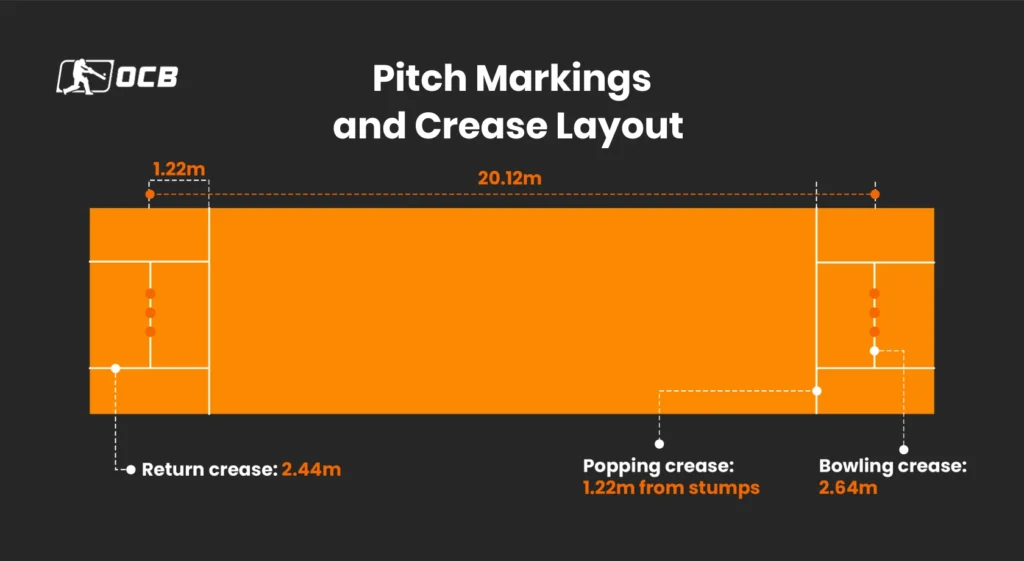What is the Length of a Cricket Pitch: Cricket Pitch Length Explained
Written by: OCB Editorial Team • 29.07.2025

When it comes to online cricket betting, having a solid understanding of cricket's fundamentals gives you a real advantage. Let’s start with one of the basics that has remained unchanged for centuries: the length of the cricket pitch. If you've ever asked, what is the length of cricket pitch, you're in the right place.
As a bettor, understanding how pitch length, pitch conditions, and venue-specific behaviour affect player performance can help you make smarter predictions. You’ll begin to recognise patterns, like which bowlers dominate at Eden Gardens or when spinners take control in Chennai.
In this comprehensive guide, we’ll break down everything you need to know about cricket pitch measurement, from official specs to betting strategy, all tailored to help you understand the game better, and make smarter bets.
Official Pitch Dimensions and Units of Measurement
| The governing bodies responsible for setting global standards are pretty clear about one thing: the cricket pitch length should always be 22 yards (or 20.12 metres). This consistent measurement helps maintain fairness across all professional matches. No matter if it's a Test at Lord's or a T20 in Mumbai, the pitch stays the same length. |
Cricket pitch length in feet, metres, and yards
The official length of a cricket pitch is 22 yards, which equals 66 feet or 20.12 metres. It’s a measurement that hasn't changed in centuries and remains consistent across all formats of the game. Whether you're watching a tense T20 in Ahmedabad or placing bets on a day-three Test in Chennai, this standard pitch length plays a massive role in how a match unfolds.
Here’s a quick reference table that breaks it all down for you:
| Unit of Measurement | Pitch Length |
| Feet | 66 feet |
| Metres | 20.12 metres |
| Yards | 22 yards |
This standardisation allows both bowlers and batters to train, perform, and strategise with a clear understanding of the playing field. For bettors, think of 66 feet as the golden number. Most broadcast graphics also show distances in feet, so this figure is especially useful when interpreting TV data or livestream stats.
Also, when betting on live games, you'll often see delivery lengths — like "short ball" or "full toss" — mentioned in feet. Knowing the full pitch length helps you visualise and respond better during live bets.
Standard width of the pitch: 3.05m
While the length gets all the attention, the standard width of the pitch is 3.05 metres (10 feet). That’s the space where all the action takes place; bowling, batting, running, and those controversial DRS calls.
The pitch width is standardised at 3.05 metres, or 10 feet. This width doesn’t just give batters their hitting zone — it defines the bowler’s attack angles, especially for left-right batting combinations.
Why should this matter for betting? A wider angle of attack, especially in spin-friendly conditions, can lead to more LBWs or stumpings — great indicators for player dismissal bets.
Knowing the pitch width helps bettors assess conditions for spin or seam bowling, especially in subcontinent venues.
Why 22 yards? Historical origin of pitch length
You might wonder why exactly 22 yards? It's not just a random number. The 22-yard pitch goes back to England in the 1700s, where land was measured in chains. This unit was already familiar to farmers and surveyors, so cricket adopted it as the pitch length. One chain equalled 22 yards — and this measurement was carried into early cricket laws.
Despite modern advances in the game, this measurement hasn’t changed in 300 years. The reason? It offers the perfect balance of time and space for both bowlers and batters to compete evenly.
From a betting angle, this historical consistency gives you the ability to compare performances from past and present. Virat Kohli’s cover drive and Sachin’s straight drive? Both played on the same 22-yard stretch.
Expert Perspective: Dhruv’s Opinion
Our in-house cricket strategist Dhruv has this to say:
“From a betting perspective, understanding pitch length isn’t just academic, t’s tactical. A 22-yard pitch behaves differently based on weather, soil, and format. Smart bettors consider whether the pitch assists swing bowlers early on or offers more grip for spinners later. The standardised length makes performance comparisons more accurate across formats.”
— Dhruv, OCB’s Lead Cricket Analyst

Join our cricket betting community
Follow us on social media to stay up to date!
Pitch Markings and Crease Specifications
Now that we’ve covered the cricket pitch length, it’s time to talk about the pitch markings. These painted lines, called creases, play a vital role in decisions related to no-balls, run-outs, and LBWs. If you're watching a game closely for betting cues, these lines often tell you where the battle is being fought.
Bowling crease: 2.64m length and stump alignment
The bowling crease, aligned with the stumps, is 2.64 metres long. This is the line bowlers must stay behind when delivering the ball.
For bettors, no-balls matter more than you might think. They often lead to free hits in T20s — and one free hit can mean six costly runs against your bowling economy bet.
Keep an eye on bowlers with a history of overstepping, especially during pressure overs.
Popping crease: 1.22m from stumps
The popping crease is 1.22 metres in front of the stumps. This is the line batters need to reach to avoid being run out. Also, it’s the marker that helps umpires check if a batter has been stumped. Watching closely? You might notice aggressive field settings when the popping crease is under pressure.
Return crease: 2.44m perpendicular to popping crease
These are the lines that run perpendicular to the popping crease, starting 1.32 metres (4 feet 4 inches) from the imaginary line joining the middle stumps, and extending at least 2.44 metres (8 feet) behind the popping crease. Bowlers need to stay within these during delivery. It's not often talked about, but breaches can result in no-balls; again, valuable info for a sharp bettor.
Wide guidelines for limited overs cricket
In ODIs and T20s, additional wide guidelines are often painted to help umpires call wide balls more consistently. These guidelines are typically positioned to extend about 432mm (17 inches) inside the return crease on either side. While the official Law defines a wide by whether the ball is out of the batter's reach, these painted lines serve as a practical visual aid for umpires. Knowing which umpires are strict about wides can help predict extra runs or pressure overs.
Protected area indicators and their placement
There’s also a protected area on the pitch just around the pitch’s centre, which is like an imaginary rectangle running down the centre, about 0.61m wide. Bowlers are not allowed to follow through into this zone repeatedly. If they do, they can get a warning or even be barred from bowling. This can affect match dynamics and your betting odds.

Pitch Variations Across Age Groups and Formats
While the official cricket boards standardise adult pitch dimensions, junior and developmental formats in (like school cricket) use varied pitch lengths. This is crucial if you're betting on domestic youth tournaments. Let’s break down how cricket pitch length varies with age and format.
Under-9 to Under-17 pitch length standards
For younger players, a full 22-yard pitch can be too much. Here’s a general idea:
| Age Group | Approx Pitch Length |
| Under-9 | 15–18 yards |
| Under-11 | 18–19 yards |
| Under-13 | 19–20 yards |
| Under-15 & up | 22 yards (standard) |
These shorter pitches help junior players develop technique before moving to the professional length.
Differences in pitch setup for men’s and women’s cricket
Cricket pitch length remains a consistent 22 yards for both men’s and women’s professional cricket. However, other factors like boundary lengths and specific pitch preparation choices may vary. For instance, pitches for some women's matches might be prepared to offer slightly less pace or bounce.
Such variations are often tactical decisions aimed at influencing game dynamics, for example, by creating conditions that could favour spin bowlers or encourage different scoring patterns. These are details pro bettors often factor into their predictions.
Junior cricket pitch length adjustments
In school-level and club cricket, coaches often adjust the pitch length depending on skill level and safety. While these variations aren't relevant in official stats, they’re critical for developmental play, and something to remember if you’re betting on youth tournaments or regional formats.
Conclusion
To summarise, the length of cricket pitch is 22 yards (or 20.12 metres / 66 feet). This measurement is not just a rule, it’s a part of cricket’s DNA. Set by the official cricket boards, the cricket pitch length in feet and other units stays consistent across formats, ages, and countries.
Why should this matter to you as a cricket bettor? Because pitch behaviour starts with pitch dimensions. The amount of swing, bounce, or turn a ball generates, these depend heavily on how well the pitch is prepared across its standardised length. If you know the cricket pitch measurement and pair that with match previews, weather reports, and venue conditions, you're already ahead of most casual punters.
Remember, betting on cricket is not just about who wins, it’s about how the game unfolds. Will spinners dominate? Are pacers likely to exploit a bouncy deck? Does the consistent 22-yard length favour slower bowlers in the death overs?
All of these are questions that find their roots in one key figure: 22 yards. So the next time you're watching a match or placing a cricket bet, remember: the pitch may look like just a strip of grass, but it’s actually a battlefield with centuries of history, science, and strategy behind it.
Want to get deeper into pitch conditions? Check out our Cricket Grounds section. And for more betting know-how, swing by our Cricket Guides.
FAQs
The length of a cricket pitch in feet is 66 feet.
The pitch is 20.12 metres long as per official cricket boards standards.
No. Since the 18th century, the pitch length has remained at 22 yards (or one chain), a traditional English unit of measurement.
Yes, junior pitches are often shorter. For example, Under-9 cricket may use pitches around 15–18 yards in length.
Absolutely. Whether it's T20, ODI, or Test cricket, the pitch length is always 22 yards (20.12m).